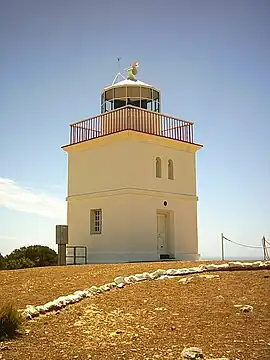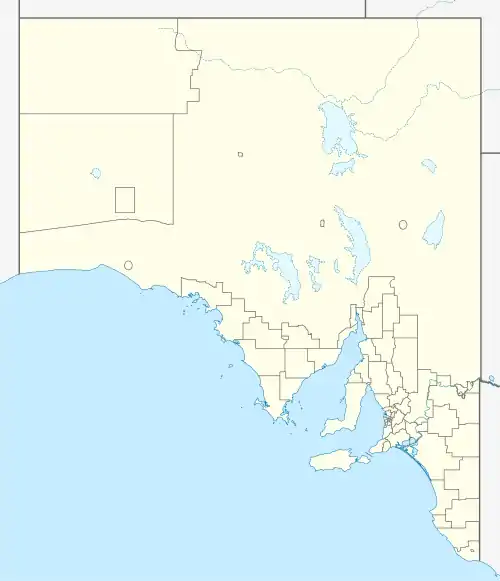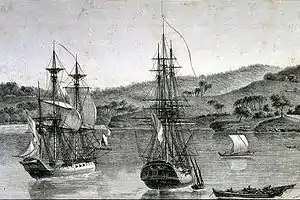Cape Borda
Cape Borda is a headland in the Australian state of South Australia located in the gazetted locality of Cape Borda on the north west tip of Kangaroo Island about 70 km (43 mi) west of the municipal seat of Kingscote. It was named after Jean-Charles de Borda (1733–1799), the French mathematician, physicist, naturalist and sailor, by the Baudin expedition to Australia during January 1803. It has been the site of an operating lighthouse since 1858 and is currently located within the Flinders Chase National Park.
| Cape Borda South Australia | |
|---|---|
 Cape Borda Lighthouse | |
 Cape Borda | |
| Coordinates | 35°44′57.2274″S 136°35′15.612″E |
| Elevation | 61 m (200 ft)[1] |
| Location | 70 km (43 mi) west of Kingscote |
Description
Cape Borda is located in the gazetted locality of Cape Borda about 70 kilometres (43 miles) west of Kingscote. It is the most north westerly point of the Kangaroo Island coast.[2] It is the termination for a pair of coastlines – the western coastline extending from Cape du Couedic in the south and the northern coastline extending from Point Marsden in the east. It is described as ‘a bold cliffy headland, 61 metres (200 feet) high’ with ‘the upper half of the cliff is formed of white limestone, and the lower half is very dark volcanic rock’ and that ‘the hills at the cape rise to a height of more than 152 metres (499 feet) and are covered with small scrub.’[1][3]
Formation, geology & oceanography
Cape Borda was formed when the sea reached its present level 7,500 years ago after sea levels started to rise at the start of the Holocene.[4] The cliff line which includes Cape Borda consists of base strata of a metasandstone belonging to the Kanmantoo group bedrock such as Middleton Sandstone and Balquhidder Formation, overlaid by a relatively thick capping of Bridgewater Formation calcarenite rock.[4][5] The water adjoining the cliff face at Cape Borda drops to depths ranging between 20 metres (66 feet) to 30 metres (98 feet).[5]
History
Aboriginal use
By 1999, the literature had not cited any archaeological discoveries specific to Aboriginal use of land in the immediate vicinity of Cape Borda.[6]
European discovery
Cape Borda was named in January 1803 by the Baudin expedition of 1800-03 in the memory of Jean-Charles de Borda (1733–1799), the French mathematician, physicist, naturalist and sailor.[7]
Navigation aid
The lighthouse at Cape Borda was the third of three provided for by legislation; the others being erected at Cape Willoughby and Troubridge Shoals (now called Troubridge Island). The light was officially lit on 13 July 1858 and was named the ‘Flinders Light’ in August 1858 in memory of Matthew Flinders.[8][9][10]
Fauna
The coast near the Cape Borda lighthouse previously supported colonies of little penguins[11] which are now believed to be extinct. Causes for local extinction are likely to include (but not be limited to) predation by increasing New Zealand fur seal populations and changes in prey availability.[12]
Protected area status
Cape Borda is currently located within the protected area known as the Flinders Chase National Park.[13] As of 2012, the waters surrounding its shores are part of a sanctuary zone located within the boundaries of the Western Kangaroo Island Marine Park.[14]
Climate
| Climate data for Cape Borda (143m ASL) | |||||||||||||
|---|---|---|---|---|---|---|---|---|---|---|---|---|---|
| Month | Jan | Feb | Mar | Apr | May | Jun | Jul | Aug | Sep | Oct | Nov | Dec | Year |
| Record high °C (°F) | 39.0 (102.2) |
36.8 (98.2) |
34.0 (93.2) |
29.2 (84.6) |
24.8 (76.6) |
20.4 (68.7) |
20.0 (68.0) |
22.0 (71.6) |
26.5 (79.7) |
32.6 (90.7) |
34.4 (93.9) |
37.0 (98.6) |
39.0 (102.2) |
| Average high °C (°F) | 23.0 (73.4) |
23.3 (73.9) |
21.3 (70.3) |
18.7 (65.7) |
16.4 (61.5) |
14.6 (58.3) |
13.9 (57.0) |
14.0 (57.2) |
15.1 (59.2) |
16.9 (62.4) |
19.4 (66.9) |
21.2 (70.2) |
18.2 (64.8) |
| Daily mean °C (°F) | 18.4 (65.1) |
18.8 (65.8) |
17.5 (63.5) |
15.6 (60.1) |
13.8 (56.8) |
12.2 (54.0) |
11.5 (52.7) |
11.5 (52.7) |
12.2 (54.0) |
13.5 (56.3) |
15.3 (59.5) |
16.9 (62.4) |
14.8 (58.6) |
| Average low °C (°F) | 13.8 (56.8) |
14.3 (57.7) |
13.6 (56.5) |
12.4 (54.3) |
11.2 (52.2) |
9.8 (49.6) |
9.1 (48.4) |
8.9 (48.0) |
9.3 (48.7) |
10.0 (50.0) |
11.2 (52.2) |
12.5 (54.5) |
11.3 (52.3) |
| Record low °C (°F) | 6.1 (43.0) |
8.0 (46.4) |
7.2 (45.0) |
6.7 (44.1) |
3.3 (37.9) |
1.8 (35.2) |
2.2 (36.0) |
2.2 (36.0) |
2.8 (37.0) |
3.3 (37.9) |
4.1 (39.4) |
6.0 (42.8) |
1.8 (35.2) |
| Average rainfall mm (inches) | 15.4 (0.61) |
16.9 (0.67) |
23.7 (0.93) |
45.2 (1.78) |
79.0 (3.11) |
106.4 (4.19) |
104.2 (4.10) |
86.5 (3.41) |
55.3 (2.18) |
41.7 (1.64) |
26.1 (1.03) |
21.0 (0.83) |
625.9 (24.64) |
| Average rainy days | 5.4 | 5.0 | 7.5 | 11.9 | 17.1 | 19.6 | 21.2 | 19.8 | 16.0 | 12.8 | 8.7 | 7.5 | 152.5 |
| Average relative humidity (%) (at 3pm) | 54 | 55 | 59 | 65 | 71 | 73 | 74 | 72 | 70 | 65 | 59 | 58 | 64 |
| Source: [15] | |||||||||||||
See also
References
- Sailing Directions (Enroute), Pub. 175: North, West, and South Coasts of Australia (PDF). Sailing Directions. United States National Geospatial-Intelligence Agency. 2017. p. 212.
- "Search result for "Cape Borda (Locality Bounded)" (Record no SA0050434 ) with the following layers being selected - "Suburbs and Localities", "Local Government Areas" and "Hundreds"". Government of South Australia. Archived from the original on 12 October 2016. Retrieved 8 March 2016.
- South Australia. Department of Marine and Harbors (1985), The Waters of South Australia a series of charts, sailing notes and coastal photographs, Dept. of Marine and Harbors, South Australia, pp. Charts 14 & 22, ISBN 978-0-7243-7603-2
- Robinson, A. C.; Armstrong, D. M. (eds.). A Biological Survey of Kangaroo Island, South Australia, 1989 & 1990 (PDF). Adelaide, SA: Heritage and Biodiversity Section, Department for Environment, Heritage and Aboriginal Affairs, South Australia. p. 26. ISBN 0 7308 5862 6. Retrieved 1 May 2014.
- Fairclough, Martin C (December 2007). "KINGSCOTE Special 1:250 000 geological map". MESA Journal. Government of South Australia, DMITRE. 47: 28–31. ISSN 1326-3544. Retrieved 18 May 2014.
- Robinson, A. C.; Armstrong, D. M. (eds.). A Biological Survey of Kangaroo Island, South Australia, 1989 & 1990 (PDF). Adelaide, SA: Heritage and Biodiversity Section, Department for Environment, Heritage and Aboriginal Affairs, South Australia. pp. 34–35. ISBN 0 7308 5862 6. Retrieved 1 May 2014.
- Robinson, A. C.; Canty, P.; Mooney, T.; Rudduck, P. (1996). "South Australia's offshore islands" (PDF). Australian Heritage Commission. p. 119. Retrieved 13 December 2013.
- "SIR H. E. F. YOUNG". Colonial Times. 4 January 1855. p. 2. Retrieved 24 June 2014.
- "Cape Borda Lighthouse, Kangaroo Island – Notice to Mariners". The Argus. 23 July 1858. p. 4. Retrieved 24 June 2014.
- "Cape Borda Lighthouse". South Australian Register. 30 July 1858. p. 3. Retrieved 24 June 2014.
- "The Ornithologists' Camp. Interesting and successful research." The Advertiser, South Australia (1905-10-25). Retrieved 2014-03-12.
- Wiebkin, A. S. (2011) Conservation management priorities for little penguin populations in Gulf St Vincent. Report to Adelaide and Mount Lofty Ranges Natural Resources Management Board. Archived 22 February 2014 at the Wayback Machine South Australian Research and Development Institute (Aquatic Sciences), Adelaide. SARDI Publication No. F2011/000188-1. SARDI Research Report Series No.588. 97pp.
- "Flinders Chase National Park, Kelly Hill Conservation Park, Ravine des Casoars Wilderness Protection Area and Cape Bouguer Wilderness Protection Area Management Plans" (PDF). Department for Environment, Heritage and Aboriginal Affairs. 1999. p. 5. Retrieved 1 May 2014.
- "Western Kangaroo Island Park Management plan summary" (PDF). Department of Environment, Water and Natural Resources. p. 27 of 29. Retrieved 23 June 2014.
- "Climate Data Online". Retrieved 14 January 2018.
